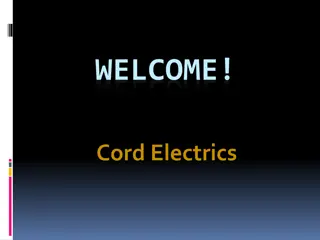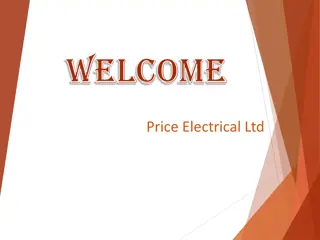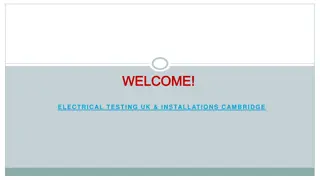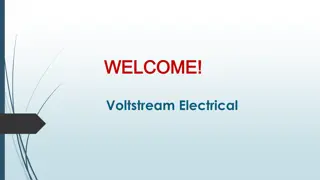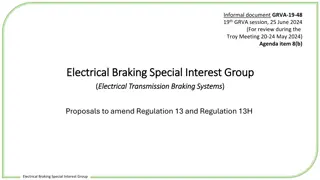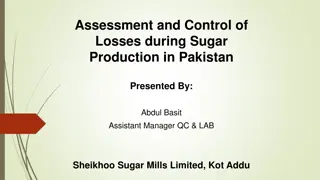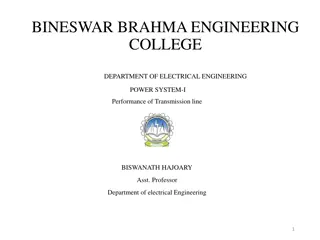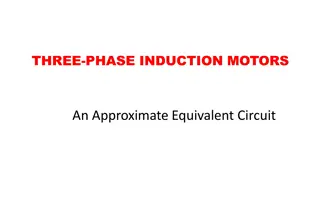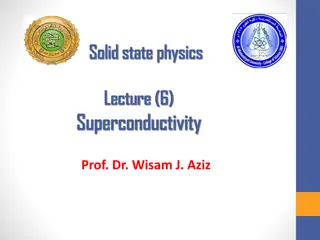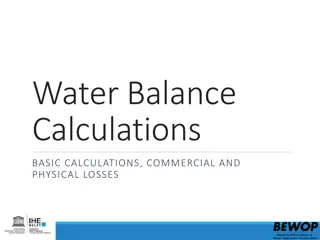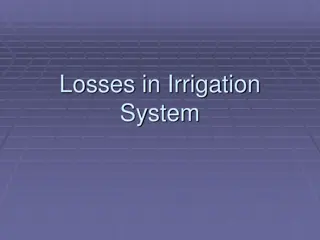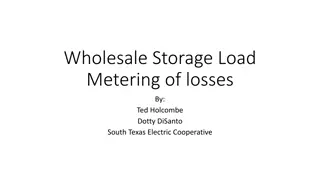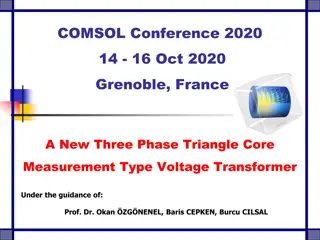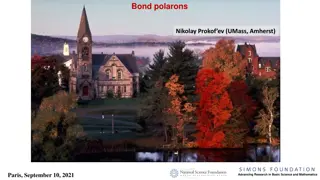Superconductivity and Electrical Transmission Losses: Exploring Potential Solutions
The lecture delves into the factors controlling electrical transmission losses, highlighting how using superconductors could lead to zero transmission loss. However, the challenge lies in the low critical temperature (Tc) of most materials. Despite the discovery of superconductivity in 1911, practical applications for large-scale power transmission face hurdles due to the need for extremely low temperatures. The BCS theory and Debye temperature play crucial roles in understanding the limitations of Tc in achieving high-temperature superconductivity.
Download Presentation

Please find below an Image/Link to download the presentation.
The content on the website is provided AS IS for your information and personal use only. It may not be sold, licensed, or shared on other websites without obtaining consent from the author.If you encounter any issues during the download, it is possible that the publisher has removed the file from their server.
You are allowed to download the files provided on this website for personal or commercial use, subject to the condition that they are used lawfully. All files are the property of their respective owners.
The content on the website is provided AS IS for your information and personal use only. It may not be sold, licensed, or shared on other websites without obtaining consent from the author.
E N D
Presentation Transcript
Lecture 12 SHANGHAI JIAO TONG UNIVERSITY LECTURE 12 2015 Anthony J. Leggett Department of Physics University of Illinois at Urbana-Champaign, USA and Director, Center for Complex Physics Shanghai Jiao Tong University
Lecture 12 - Applications SJTU 12.1 ELECTRICAL POWER GENERATION US China World Total annual electricity production ~4 ~3 ~19 (1012 kwh) Fraction dissipated in transmission Fraction from non- fossil sources ~8% ~7% ~30% (mostly nuclear) ~15% (mostly hydro) ~35%(+) (nuclear +hydro) With increased use of non-fossil sources, fraction of generated energy dissipated in transmission is likely to increase substantially over next few decades, unless
WHAT CONTROLS ELECTRICAL TRANSMISSION LOSSES? SJTU 12.2 For a given current, the loss is proportional to the resistance (R). The resistance is proportional to the distance over which power is transmitted, but for fixed distance depends on the material. R=V/I R depends on temperature (T):e.g., for Cu R T room temperature So no great gain by cooling power lines. But: R T Superconductivity, R=0
EXPERIMENTAL FACT: For temperature below some critical temperature Tc (which depends on the material ) and current below some critical current density Jc (ditto), many materials including Al are superconductors, I.e., have zero (dc)* resistance. If we could use superconductors for long-distance power transmission, we would have SJTU 12.3 ZERO TRANSISSION LOSS! Some other advantages of using superconductors for transmissional storage of electrical energy: Automatic quenching of runaway current High current density smaller transmission lines (e.g. underground) Lossless magnetic energy storage ALAS, ONE SLIGHT PROBLEM: IN MOST MATERIALS, Tc IS VERY LOW! superconductivity e.g.Al: R room temperature Absolute zero Tc (0 K, -273.15 C) (1.3K, -271.8 C) *Ac resistance is nonzero but extremely small at low (~50 Hz) frequencies
Superconductivity was discovered in 1911, and for the next 75 years was found to occur only under ~25 K (-248 oC). To get to such low temperature one must to cool material with liquid helium. So while it s practical to use superconductors for e.g., geophysical magnetometry, application to large scale power transmission out of the question (not enough helium in the world!) WHY IS Tc SO LOW? BCS theory gives an explanation: Tc~TD F Characteristic ( Debye ) temperature of ionic lattice, typically~room temperature. In BCS theory, there are strong arguments that the factor F can never exceed ~0.1 Tc always 30 K (-243oC) . AND YET SJTU 12.4 Dimensionless factor
THE HIGH-TEMPERATURE (CUPRATE) SUPERCONDUCTORS SJTU 12.5 Generic Pattern: CuO2 charge reservoir layers Coper oxide) planes example: CuO2 CuO2 SrO BiO BiO SrO BSCCO-2212 (Bi2Sr2CaCu2O8) (Tc=95K) CuO2 CuO2 ( ), Critical current is very high along CuO2 planes much smaller perpendicular to planes ( ) Magnetic field In practice, critical current usually determined by motion of vortices, which always occur in a large magnetic field: vortex moves perpendicular to field and to current, and thereby produces voltage Circulating current field current nonzero resistance. Motion of vertex
APPLICATION OF HIGH-TEMPERATURE SUPERCONDUCTIVITY TO GRID: SJTU 12.6 2 MAJOR AVENUES OF RESEARCH 1.Using existing (cuprate) high-temperature superconductors (BSCCO, YBCO(YBa2Cu3O6+x), ) Already practical for special purposes (e.g. transformers, current fault limiters, offshore wind power ). Also, pilot cables (up to ~1 km) already in operation. But, for large-scale power transmission, need (inter alia) - large reduction in manufacturing cost (currently >> Cu) -reduction in cost of refrigeration (50-77K) - most importantly: increase in Jc(H,T) temperature critical current magnetic field Since the factor limiting electrical current is motion of vortices, most promising route to higher Jc is to final better ways to pin vortices. (ex.:irradiate with fast ions so as to produce columnar defects) What microscopic conditions are best for pinning of vortices? A major challenge to current microscopic theory of superconductivity in cuprates!
2nd major avenue of research: SJTU 12.7 2. By understanding superconductivity in cupraters, or otherwise, find better high-temperature superconductors (ideally: Tc>room temperature, large Jc(H,T)). Problem: we don t understand superconductivity in the cuprates! (in particular, why Tc is so high). Recall: to form di-electronic molecules appear to need effective attractive between electrons. In BCS theory this can be provided by polarization of ionic lattice. (but then predicts Tc 30K). Anyway, much evidence that in cuprates effect of ionic lattice is at best secondary. So, much get superconductivity out of Coulomb repulsion between electrons! This is a MAJOR challenge for theoretical condensed matter physics (~104 papers since 1986) If we can solve it, then we may know where to look for room temperature superconductivity in the haystack of possible compounds. (no. of possible 5-element compounds ~1010 106 person-years of research!) My guess: look for Strongest possible repulsion Strongly layered (2D) structure weak inter-layer tunneling contact anomalous optical properties ( MIR peak )
Other (actual and potential) applications: SJTU 12.8 Superconducting levitation: (Condensation energy of YBCO at ? = 0 0.5 MJ/m3 : energy neccessary to levitate Tosanoumi 15 J . sumo wrestler main problem: "mobile" supply of liquid N2! again, room-temperature superconductivity would solve problem.... Magnetometry: Recall that for dc SQUID ? = ??0|cos? / 0| very accurate measurement of , hence of ?. applications: magnetoencephalography, geographical prospecting... Quantum computing: needs set of two-state systems ("qubits") such that one can prepare and manipulate quantum superpositions of form = ?| + ?| while minimizing effects of decoherence. Prima facie optimal candidates: microscopic systems well shielded from environment (nuclear spins, trapped single ions...) But...


